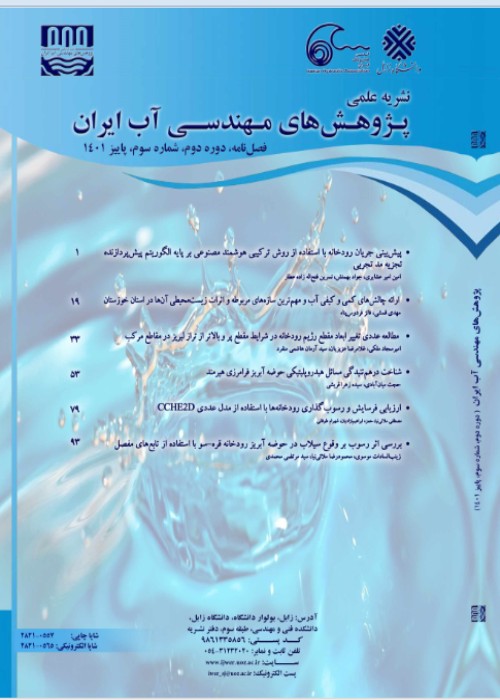Investigation of the effects of the construction of the new breakwater on Rivers connecting Anzali lagoon and port
Breakwaters are one of the first offshore structures to create calming ponds for mooring ships. Numerous studies have been conducted in numerical modeling of sediment transport and the evolution of shore morphology against coastal waves and currents (Sverdrup and Munk, 1947; Gelsi et al., 1957; Phillips, 1957; Miles, 1957; Hasselmann,1974).Examining the effects of coastal structures on coastal sediment transport demonstrates that the construction of ports or breakwaters causes coastal erosion and sediment accumulation and distribution (El-Asmar and White, 2002; Bohlolei et al., 2005; Tang et al., 2017; Sakhaee and Khalili, 2020).Anzali wetland, one of Iran's most sensitive aquatic ecosystems, is connected to Anzali Port tranquility basin through several Rogas. Due to the lack of wharves' capacity, decision-makers provide a program to develop this port. Fig. 1 shows the port of Anzali before and after development. Simultaneously with the construction of new port breakwaters, changes were observed in the wetland conditions and sediment accumulation at the wetland margin.In this paper, simulation of waves and water flow and sediment in Bandar Anzali area before and after port development investigates the effect of new Anzali breakwaters on the daily bed change rate and sediment concentrations increase using MIKE 21 software.
MIKE 21, a subset of MIKE software, is a comprehensive system for modeling open and two-dimensional flows in which fluid flow layering can be neglected.We took the information related to depth measurement, hydrodynamic, sediment, border conditions (Fig. 2), and Wind (Fig. 3) to provide the model. The hydrographic maps belong to 1) November 2007 (before the development of Bandar Anzali) and 2) February 2017 (after development). The solution area was divided into a network. Then, the second hydrographic file was fed to the Mesh Generator module of the MIKE 21 SW module. Comparing the height of waves of this model with the height of the buoy waves and the waves of the previous stage in each trial and error led to selecting network dimensions, Fig. 4. Hereafter, it was modified for the state of before development. Subsequently, it was altered for stage 1, before development.The MIKE 21 Spectral Waves SW madule were used to simulate the waves, and the non-cohesive sediment transport sub-model was used to model sediment flow. Simulation was run for both stages.
Fig. 8-(a) shows that the daily bed change (DBC) rate for before development in most areas of the port basin is less than 0.001 m/day, and only a tiny part of the Nahange-Bozorg Roga experiences larger values. It takes values greater than 0.002 and 0.003 m/day in the center of Nahang Roga. At the junction of Pir-Bazar Roga and Sousar Ruga, the DBC rate is more than 0.003 m/day. Also, at the intersection of the four rivers, a minor part has a value of more than 0.003 m/day. However, Shanbe-Bazar Roga did not illustrate a significant amount of DBC.Fig. 8-(b) illustrates that the rate of DBC after development in most areas of the port basin is about 0.001 m/day, and only the southern borders and a part of Shanbe-Bazar Roga the rate values are more than 0.002 m/day; however, even 0.004 m/day. In a large area of the intersection of Pir-Bazar Roga and Sousar Roga, the rate takes a litter change of more than 0.002 and 0.004 m/day. Also, along with all four rivers outlets, there is a length with a rate amount of more than 0.002 m/day. Furthermore, in a tiny part of Shanbe-Bazar Roga, the amount rate of DBC is more than 0.002 m/day.Comparing Fig. 9-(a) and b shows that the concentration of suspended sediments (CSS) after development in most areas of the port basin is about 1.5 g/m3, and only the southern borders and a part of Shanbe-Bazar Roga show larger values, which is more significant than 0.8 g/m3 before development. However, in the eastern part of the study area and the region where Shanbe-Bazar Roga connects to the tranquility -basin, CSS is about 3 g/m3. The Pir Bazar and the Nahange-Bozorg do not report significant amounts of CSS, and for most of the length of Nahang Roga, CSS is about 4 g/m3. The maximum rate of CSS occurs in 100 meters length of Sousar Roga, along Which CSS has reached 13 g/m3, and at last 1 meter of that, it shows the amount of 15 g/m3.
Areas that have experienced a change in DBC in post-development conditions compared to port pre-development are 1) a small area of Shanbe-Bazar Roga, 2) the junction of Nahang Roga and Nahang-e-Bozorg Roga, 3) the connection of Sousar and Pir-Bazar Roga, and 4) Southern region, the intersection of Nahang, Pir-Bazar, and Sousar Rogas.In terms of sediment concentration, an increase was reported along 300 meters of Sousar Roga.The new breakwaters are the only difference between pre-and-post development modeling of the Anzali port basin; thus, they can effectively change flow transfer from the lagoon to the sea. However, since the difference in the DBC and CSS value rate is low, the construction of new breakwaters can not be the leading cause of the wetland destruction process during the past years, and other factors affecting this water area need to be considered.
- حق عضویت دریافتی صرف حمایت از نشریات عضو و نگهداری، تکمیل و توسعه مگیران میشود.
- پرداخت حق اشتراک و دانلود مقالات اجازه بازنشر آن در سایر رسانههای چاپی و دیجیتال را به کاربر نمیدهد.


